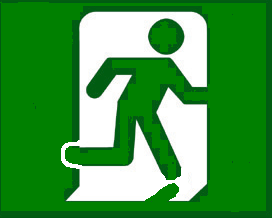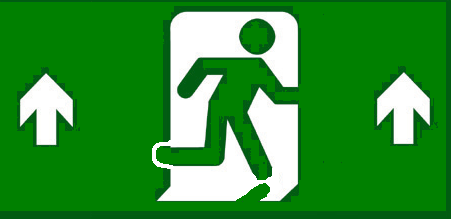AMC
25.812(b)(1) Emergency lighting
ED Decision 2017/015/R
General Requirements
Emergency exit signs should consist of a consistent type throughout the
aeroplane. They may be letter based or symbolic, as outlined below.
Letter based emergency exit signs should use letters with a height to
stroke width ratio of not more than 7:1 nor less than 6:1.
Symbolic emergency exit signs should be white and green in compliance
with European Standard (EN) ISO 7010:2012, Graphical symbols, safety colours
and safety signs, registered safety signs. The green area of the sign should
constitute at least half of the total area of the sign.
In determining the area of an emergency exit sign, no part of the sign
outside of the white background (text signs) or green element (symbolic
signs), for instance a surrounding contrasting border, should be included.
Minimum size - emergency exit signs
required by CS 25.811(d)(1) or (d)(3)
For each emergency exit sign required by CS 25.811(d)(1), and for each emergency exit sign required on each bulkhead or divider by CS 25.811(d)(3), at each point along any possible aeroplane egress path, the next closest required emergency exit sign visible at each point along the egress path should be sized and located such that it is no farther away from the escapee than its maximum allowable viewing distance calculated as below.
Egress paths to be assessed should be:
(1) any possible path from a passenger seat that can be occupied during taxiing, take-off, and landing to any passenger emergency exit; and
(2) any possible path from a point adjacent to any passenger emergency exit to any other passenger emergency exit.
Calculation of maximum viewing
distance
For an emergency exit sign required by CS 25.811(d)(1) and for an emergency exit sign required on each bulkhead or divider by CS 25.811(d)(3), the following formulae, as modified by the notes below, apply for calculating a maximum viewing distance. The maximum allowable viewing distance for a sign is in each case the lower of the two values D1 and D2:
|
Text based
signs |
Symbolic signs |
|
D1 = 2. Z . hletter. |
D1 = 1.25 . Z . hsymbol. |
|
D2 = Z . √(xsign/2.5) |
D2 = Z . √(xsign/2.5) |
where:
1. Z is the distance factor obtained from
Table 1 below;
2. hletter is the overall height of
each letter – which should be at least of 25 mm (1 inch) high;
3. hsymbol is the overall height of
the white symbolic element incorporating the green ‘running man’ – which
should be at least 40 mm (1.6 inches) high;
4. xsign is the overall area of the
sign; and
5. D1, D2, hletter and
hsymbol have the same units, and xsign is in the
same squared units as D1, D2, hletter and
hsymbol.
Note 1: In the case of dual-language text based emergency exit signs, only the English text is to be considered when selecting hletter for use in the above formula. However, in determining the area of the sign (xsign) for use in the above formula, the actual area may be used
Examples
of acceptable designs of symbolic exit signs
|
CS 25.811(d)(1) (emergency
exit locator sign) |
|
|
CS 25.811(d)(2) (emergency
exit marking sign) |
|
|
CS 25.811(d)(3) (emergency
exit sign on bulkhead or divider) |
|
Table 1:
Z factor to be used for text based and symbolic emergency exit signs
|
Mean luminance
of white contrast |
Distance factor
Z |
|
³
1.27 candela/m2 (0.37 ft-L) ³
10 candela/m2 (2.92 ft-L) |
100 150 |
|
³ 30 candela/m2 (8.76 ft-L) |
175 |
|
³ 80 candela/m2 (23.35 ft-L) |
200 |
|
³ 200 candela/m2 (58.37 ft-L) |
215 |
|
³ 500 candela/m2 (145.93 ft-L) |
230 |
Minimum size - emergency
exit signs required by CS 25.811(d)(2)
For an emergency
exit sign required by CS 25.811(d)(2), any sign using English letters of
at least 25 mm (1 inch) height, or a white symbolic element (i.e. that
part incorporating the green ‘running man’) of at least 40 mm (1.6
inches), with an overall area of at least 64.5 cm2 (10 square
inches) will be acceptable.
Supplementary
directional arrows
The inclusion of
an arrow or arrows in any of the signs discussed above, in order to increase
the comprehension of the sign, is encouraged. The possibility to improve
comprehension and the appropriate orientation of the arrows will depend on the
particular installation. If arrows indicate a movement other than straight
ahead, in the case of a symbolic sign, the depicted movement direction of the
‘running man’ (to the right/to the left) should be chosen to be compatible
with the orientation of the arrow(s). There may be other reasons to choose a
particular movement direction of the ‘running man’, for instance where a sign
required by CS 25.811(d)(2) is placed to the left or right of the
emergency exit. In this case, the ‘running man’ should not suggest movement
away from the emergency exit.
In the case of symbolic signs, the arrows should be in accordance with the style defined in European Standard (EN) ISO 7010:2012, i.e. type D of ISO 3864-3. The ratio of overall length of an arrow to the width of its tail should be not more than 7:1 nor less than 5.5:1.
[Amdt 25/3]
[Amdt 25/19]


